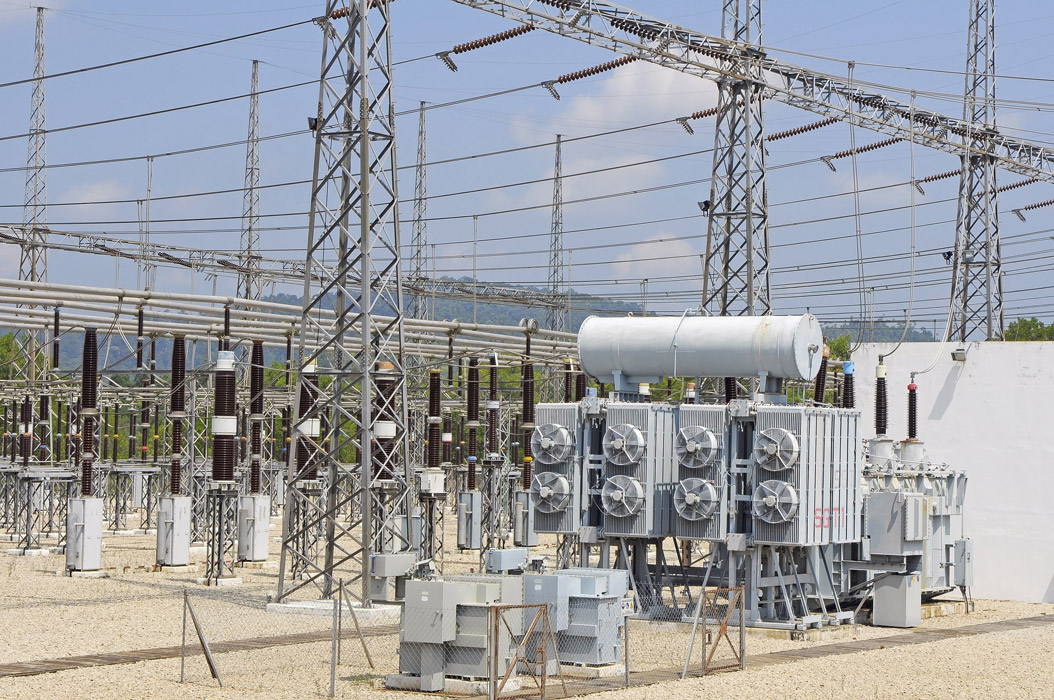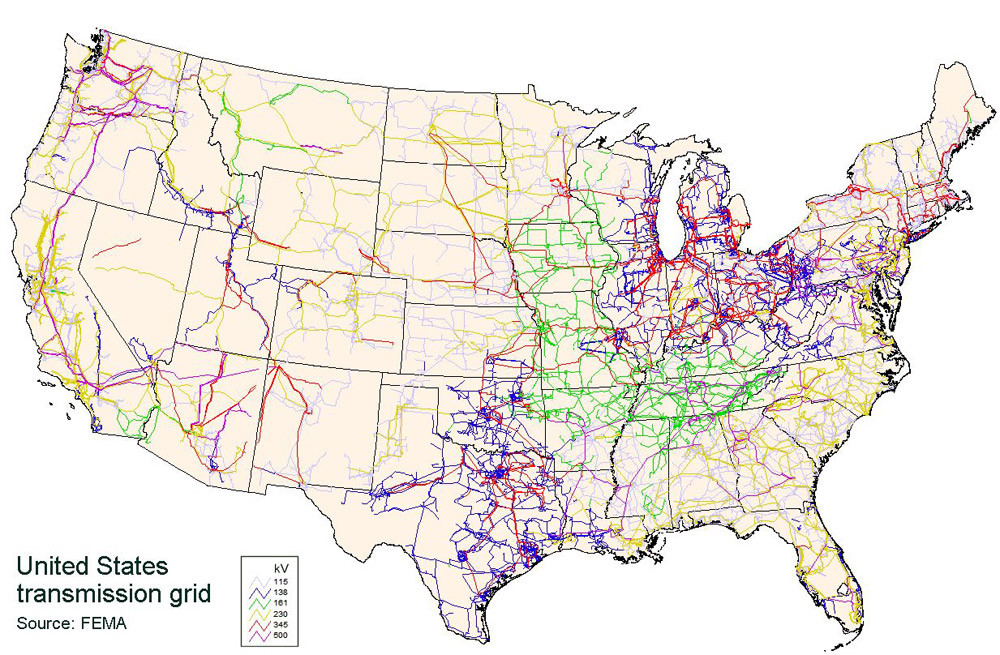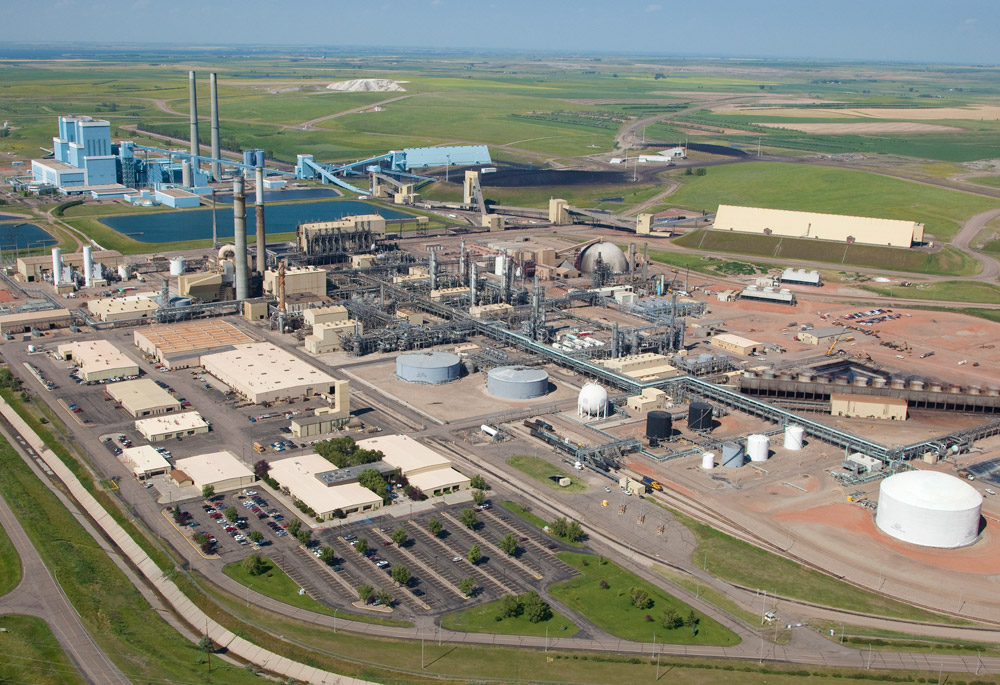- Lignite is "shipped by wire" in the form of electricity in North Dakota and to other surrounding states.
-
All of the people in North Dakota, as well as 1.5 million people in surrounding states use electricity produced from North Dakota lignite.
 Substation: A substation outside Basin Electric's Antelope Valley Station near Beulah transforms the voltage leaving the plant to be transported via transmission lines.
Substation: A substation outside Basin Electric's Antelope Valley Station near Beulah transforms the voltage leaving the plant to be transported via transmission lines. - North Dakota has more than 65,000 miles of transmission and distribution lines.
- Transmission lines are high-voltage lines that carry electricity long distances.
- Distribution lines carry lower-voltage electricity from a local substation to nearby homes.
- Electricity generated at a power plant is sent by wire to a transformer.A transformer is a device that changes the voltage of the electricity.
- The voltage of electricity produced at a power plant ranges from about 2,300 to 22,000 volts (2.3 to 22 kilovolts).
- The transformer increases the voltage to a range of about 155,000 to 765,000 volts.
- When the voltage is high, less electricity is lost along the way.
- The electricity is then sent to the electric grid.
- The transformer increases the voltage to a range of about 155,000 to 765,000 volts.
- The voltage of electricity produced at a power plant ranges from about 2,300 to 22,000 volts (2.3 to 22 kilovolts).
A volt is the measure of electric pressure that causes electrons to move from one atom to another. Voltage is supplied by a battery or a generator. One kilovolt is 1,000 volts. Current is electricity in motion. Electrical power (watts) is Current x Volts.

US Power Lines: This map shows high voltage transmission lines throughout the United States – 115 kilovolts and up. The smaller distribution lines (wires that carry electricity to homes) are not shown on this map. Map courtesy of the Federal Emergency Management Agency.
- The electric grid is a network of transmission lines strung on giant towers. The United States has three electric grids. North Dakota is in the eastern grid, but most of Montana is in the western grid. Texas has its own grid.
- Substations along the electric grid contain transformers that decrease the voltage to 12,000 volts.
- Electricity is then carried over distribution lines to homes.
- Before the electricity enters a home, it goes through another transformer that further decreases the voltage to 240 and 120 volts.
- Lower voltage is generally safer, but higher voltage is generally more efficient.
- Large appliances such as clothes dryers and stoves use 240 volts; other household appliances, lights, outlets, etc. use 120 volts.
- Before the electricity enters a home, it goes through another transformer that further decreases the voltage to 240 and 120 volts.
- BSC Energy Resource Tool: Visit the Energy Flow page to see how power gets from the plant to your house.
Synthetic natural gas:
- About 20 percent of North Dakota's lignite is used to make synthetic natural gas and fertilizer products.
A synthetic product is a product made by chemical synthesis to imitate a natural product. Gasification is a thermo-chemical process in which a carbon-rich material such as coal is converted to a gas. In North Dakota, synthetic natural gas is made from lignite.

Energy Campus: In order to save money on transportation costs, North Dakota's power plants are located near the mines. This picture shows the Antelope Valley Station, the Great Plains Synfuels Plant, and the Freedom Mine near Beulah. Both plants use coal from the Freedom Mine to cut down on transportation costs. Photo courtesy of Basin Electric Power Cooperative.
- The Great Plains Synfuels Plant near Beulah is the only commercial-scale coal gasification plant in the United States that manufactures synthetic natural gas from lignite coal.
- About 18,000 tons of lignite are used at this plant each day.
- The coal comes from the Freedom Mine.
- Approximately 160 million cubic feet of natural gas is produced each day at Great Plains Synfuels Plant.
- The Northern Border Pipeline transports the synthetic natural gas to the eastern part of the United States.
- About 225,000 homes and businesses in the East use synthetic natural gas from Great Plains Synfuels.
- About 18,000 tons of lignite are used at this plant each day.
- Besides synthetic natural gas, Great Plains Synfuels produces fertilizer products including liquid nitrogen and anhydrous ammonia, and urea.
- These products are marketed throughout the United States and worldwide.
- Gasifying coal is one of the best ways to clean pollutants out of coal.
- Pollutants such as carbon dioxide, sulfur, and nitrogen are converted into useful products.
- Carbon dioxide produced at Great Plains Synfuels is piped through a 200-mile pipeline to oil fields in Saskatchewan.
- It is used in enhanced oil recovery, which is a technique to extract more crude oil from an old oil field.
- In the very near future, the Great Plains Synfuels plant will be sequestering CO2 deep underground.
- Carbon dioxide produced at Great Plains Synfuels is piped through a 200-mile pipeline to oil fields in Saskatchewan.
- Pollutants such as carbon dioxide, sulfur, and nitrogen are converted into useful products.


